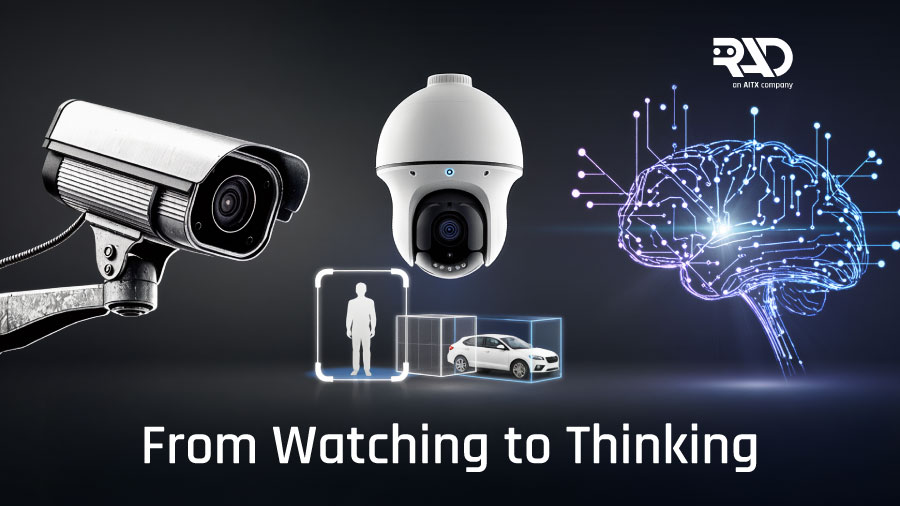Not long ago, security cameras were little more than electronic witnesses. They silently captured hours of grainy footage, endlessly recording whether anything happened or not. Most of that footage was never seen, unless someone had the time to rewind and scan through tape. These cameras didn’t know what they were looking at, they simply watched.
Fast forward to today, and the story has changed dramatically. Cameras no longer just see, they interpret. They distinguish between people and vehicles, they read license plates, they recognize safety compliance, and they even detect firearms. And now, with the arrival of agentic AI like RAD’s SARA™, cameras have stepped into an entirely new role: reasoning, deciding, and even communicating in real time.
The journey from simple motion detection to agentic AI is more than an evolution of features, it’s the transformation of security itself.
The Dawn of Motion Detection
The first breakthrough came when cameras learned to respond to movement. Instead of running endlessly, they could wait until something crossed their field of view before recording. This shift saved time, storage, and costs, and it marked the beginning of cameras doing more than just pointing and capturing.
Of course, early motion detection was far from perfect. A branch swaying in the wind or a passing shadow could trigger an alert just as easily as an actual intruder. But the idea that a camera could act only when something happened laid the groundwork for everything that followed. Motion detection was the first spark that transformed cameras from passive devices into active participants in security.
Recognizing the Difference: Human and Vehicle Detection
As technology advanced, cameras became smarter about what they were seeing. It was no longer just “something moved,” but rather “a person walked in” or “a vehicle entered.” That distinction changed everything.
False alarms dropped, responses improved, and security teams gained a clearer picture of what actually mattered. For businesses, this meant fewer wasted hours chasing meaningless alerts. For investors and industry leaders, it demonstrated how analytics could turn basic surveillance into a valuable decision-making tool.
This was the point where cameras began shifting from motion detectors to true identifiers, moving closer to the intelligent systems we rely on today.
Specialized Insights: LPR, PPE, and Firearm Detection
Once cameras could tell the difference between a person and a vehicle, the next step was to recognize specifics. License Plate Recognition linked vehicles to identities, adding accountability at gates and parking lots. Cameras monitoring construction sites learned to confirm whether workers were wearing helmets or vests, improving compliance with safety protocols. And firearm detection emerged as a powerful safeguard, identifying visible threats before they escalated.
Each of these advancements gave cameras a sharper vocabulary. They were no longer just spotting movement or shapes, they were interpreting context. Security teams gained better intelligence, organizations saw new ways to protect assets and people, and the industry discovered that cameras could be more than silent observers.
The Leap to Agentic AI: Enter SARA
Detection alone could only go so far. The real transformation came when cameras and connected devices gained the ability to think, reason, and act. This is the era of agentic AI, and SARA (Speaking Autonomous Responsive Agent) is leading the way.
SARA does more than observe. She interprets what she sees, weighs the context, and decides the right response. If an unauthorized person appears, she can speak directly to them, notify security personnel, place calls, send texts, or escalate to law enforcement. Unlike traditional systems that wait for humans to notice an alert, SARA communicates in real time, taking immediate steps that reduce risk and protect assets.
For end-users, this means fewer gaps in security and faster responses. For investors, it signals a market where automation and intelligence are driving measurable growth. For industry leaders, it represents the moment where cameras stopped being tools and started becoming partners.
From Seeing to Thinking: What Comes Next
The story of security cameras has always been about evolution. First, they learned to notice movement. Then they learned to tell people from vehicles. Soon they could recognize license plates, safety gear, and even weapons. Each step pushed cameras further from passive recorders toward intelligent tools.
Now, with agentic AI like SARA, cameras have crossed a threshold. They no longer just see or detect, they reason, engage, and communicate. Security has moved from watching and reporting to acting and partnering.
What comes next is not just sharper images or faster alerts, but systems that think alongside us. For businesses, investors, and communities, this is the future of security: smarter, faster, and always responsive.
Don’t hesitate, contact us today to schedule a consultation and see for yourself the benefits of implementing RAD’s innovative technology. Our team is ready to answer any questions you may have and provide you with the information you need to make an informed decision. Don’t miss out on this opportunity to upgrade your security system – contact us today!

